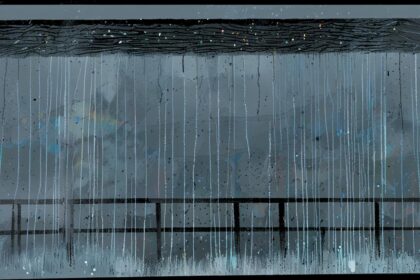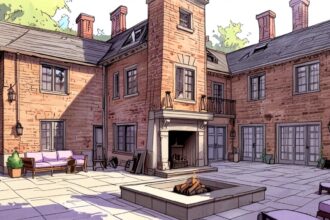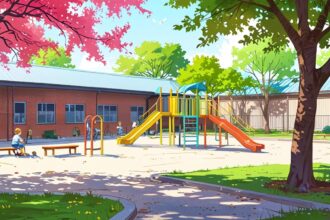Once seen as temporary wartime solutions, prefab homes built after World War II continue to stand as symbols of resilience, reflecting a unique era of social cohesion and innovative housing in Britain. Their evolving legacy highlights challenges and triumphs in addressing urgent housing needs while fostering community spirit.
The Legacy of Prefab Homes: A Snapshot of Post-War Britain
Across Britain, 8,000 prefab bungalows quietly inhabit the landscape, their unassuming exteriors hiding a profound narrative steeped in the aftermath of World War II. Initially perceived as a temporary solution to a pressing housing crisis, these structures offer a unique glimpse into a transformative era in British social history. Between 1945 and 1949 alone, a staggering 156,623 prefabricated homes were erected, designed to provide swift relief to the substantial number of families displaced by wartime destruction.
The decision to construct prefab homes was the brainchild of a committee set up by Prime Minister Winston Churchill during the war. With skilled tradesmen conscripted into military service, the nation faced a massive backlog of housing. As highlighted by Jane Hearn, founder of the Prefab Museum, “Bricklayers, plasterers, electricians and plumbers had all been called up to fight in the war,” leaving a dire shortage of workers to repair or rebuild homes. The prefab model, inspired by American practices, provided an innovative solution. These homes could be constructed off-site and then assembled quickly, with some being completed in as little as 42 minutes, according to historical records.
Initially intended to last only a decade, many prefabs defied expectations, serving as homes for generations. As the reality set in that traditional brick and mortar solutions were insufficient for the housing crisis, the government pivoted from its initial warranty to demolishing many of these structures in favour of high-density tower blocks. Ironically, the very characteristics that made prefabs appealing — spacious layouts with gardens — became liabilities as local councils sought to maximise housing density.
Living in a prefab home often fostered a strong sense of community. As depicted through personal stories, the shared experiences of residents frequently contributed to enduring networks of support. David Thompson, who grew up in Dudley, fondly recalls a “real community feel” surrounding his prefab home, where outdoor spaces allowed children to play freely and neighbours, whether they were ex-soldiers or ordinary citizens, supported each other. Similarly, John Wilson, raised in a prefab in Cambridge, remembered the “strong sense of community” prevalent in his neighbourhood, evoking images of vibrant gatherings, including a street party for Queen Elizabeth II’s coronation.
While many reminisced about the benefits of these homes, challenges were well-documented too. Issues such as cold interiors and damp problems emerged over time. As Andrew Lester noted, despite the communal joys of living in a prefab, the homes were intended to be temporary dwellings, often resulting in eventual relocations when maintenance issues became insurmountable.
The charm of these prefab homes, however, lies not just in nostalgia but also in their architectural significance. Some have gained listing status from Historic England, highlighting their importance as cultural artefacts of a bygone era. Recent discussions around the remaining prefab homes underscore their valuable place in British history and the need for their preservation.
As Britain reflects on its past, the survival of these prefabs embodies resilience and adaptability in the face of adversity. They remind us of a time when community bonds were forged in service of rebuilding lives ravaged by war. Prefabs may be relics of history, but they continue to evoke memories of a collective spirit that transcended the hardships of the day.
As conversations around housing policy and community living evolve in the current era, the legacy of prefab homes serves as a compelling case study in addressing housing needs and nurturing social cohesion.
Reference Map:
- Paragraph 1 – [[1]](https://news.google.com/rss/articles/CBMilwFBVV95cUxQdU81a1YtdjJZd1UzdVNtNEg5S2s2QTFkZ2NjMW05X2hBRG14enIzY3UzMzRfdHlFRENpMFRrcG9BZFREb3FJTFVBOTllaDU2MERQZjdkMjBkdkRpR3E1ZFdRcDUtbmVqNW1xbkVvUUVSLWFkdXZHelEzR1pPdHlEZ2RvOGVra1BDbHhyazgxUUVzdXlzYm9B0gGcAUFVX3lxTE82c195UzFsejV6NFJGUEZDVDBHQUJ2QWpDYVNhZWxzVU5TQUtDYWdKbkMtM1BtT2pmZ01FWmJxaG5PTWxvNmVyNW1zejhPUG1pcXlsQWtwRlB4dW9JWmdxQmJmNThOWjNiOHpSQjhJYlVDbDUzcE95MXZHanBJTmpjSlNZQWEzRndzQWloaHp2d29CR1Ntc2tIcF9pWA?oc=5&hl=en-US&gl=US&ceid=US:en), [[3]](https://www.bbc.com/news/uk-england-london-68922873)
- Paragraph 2 – [[2]](https://en.wikipedia.org/wiki/Prefabs_in_the_United_Kingdom), [[5]](https://www.sevenoaksmuseum.org.uk/blog/coming-home-displacement-during-and-after-ww2/)
- Paragraph 3 – [[4]](https://www.bbc.com/news/uk-wales-51613917), [[6]](https://www.manchestereveningnews.co.uk/news/nostalgia/rise-fall-prefab-council-estates-21535055)
- Paragraph 4 – [[1]](https://news.google.com/rss/articles/CBMilwFBVV95cUxQdU81a1YtdjJZd1UzdVNtNEg5S2s2QTFkZ2NjMW05X2hBRG14enIzY3UzMzRfdHlFRENpMFRrcG9BZFREb3FJTFVBOTllaDU2MERQZjdkMjBkdkRpR3E1ZFdRcDUtbmVqNW1xbkVvUUVSLWFkdXZHelEzR1pPdHlEZ2RvOGVra1BDbHhyazgxUUVzdXlzYm9B0gGcAUFVX3lxTE82c195UzFsejV6NFJGUEZDVDBHQUJ2QWpDYVNhZWxzVU5TQUtDYWdKbkMtM1BtT2pmZ01FWmJxaG5PTWxvNmVyNW1zejhPUG1pcXlsQWtwRlB4dW9JWmdxQmJmNThOWjNiOHpSQjhJYlVDbDUzcE95MXZHanBJTmpjSlNZQWEzRndzQWloaHp2d29CR1Ntc2tIcF9pWA?oc=5&hl=en-US&gl=US&ceid=US:en), [[3]](https://www.bbc.com/news/uk-england-london-68922873)
- Paragraph 5 – [[5]](https://www.sevenoaksmuseum.org.uk/blog/coming-home-displacement-during-and-after-ww2/), [[7]](https://www.theguardian.com/society/2002/nov/20/urbandesign.architecture)
Source: Noah Wire Services
- https://news.google.com/rss/articles/CBMilwFBVV95cUxQdU81a1YtdjJZd1UzdVNtNEg5S2s2QTFkZ2NjMW05X2hBRG14enIzY3UzMzRfdHlFRENpMFRrcG9BZFREb3FJTFVBOTllaDU2MERQZjdkMjBkdkRpR3E1ZFdRcDUtbmVqNW1xbkVvUUVSLWFkdXZHelEzR1pPdHlEZ2RvOGVra1BDbHhyazgxUUVzdXlzYm9B0gGcAUFVX3lxTE82c195UzFsejV6NFJGUEZDVDBHQUJ2QWpDYVNhZWxzVU5TQUtDYWdKbkMtM1BtT2pmZ01FWmJxaG5PTWxvNmVyNW1zejhPUG1pcXlsQWtwRlB4dW9JWmdxQmJmNThOWjNiOHpSQjhJYlVDbDUzcE95MXZHanBJTmpjSlNZQWEzRndzQWloaHp2d29CR1Ntc2tIcF9pWA?oc=5&hl=en-US&gl=US&ceid=US:en – Please view link – unable to able to access data
- https://en.wikipedia.org/wiki/Prefabs_in_the_United_Kingdom – This Wikipedia article provides a comprehensive overview of prefabricated homes in the UK, detailing their inception during World War II to address the housing shortage. It discusses the Housing (Temporary Accommodation) Act 1944, which authorized the construction of 300,000 prefabricated houses within ten years, and the actual construction of 156,623 prefab houses between 1945 and 1951. The article also highlights the durability of these homes, many of which have survived well beyond their intended lifespan.
- https://www.bbc.com/news/uk-england-london-68922873 – This BBC News article explores the history and impact of prefabricated homes in post-war Britain. It notes that nearly 500,000 homes were built using some form of prefabrication in the first decade after World War II. The article emphasizes that these homes, originally intended as temporary solutions, have often exceeded their expected lifespan, with about 8,000 still standing today. It also mentions that some have been listed by Historic England for their architectural significance.
- https://www.bbc.com/news/uk-wales-51613917 – This BBC News article discusses the role of prefabricated homes in addressing the housing shortage in post-war Britain. It mentions that more than 156,500 prefabs were erected across the UK in the three years after World War II. The article highlights that these homes were intended to provide temporary accommodation for those affected by air raids but were well-equipped and often popular with residents, with some lasting well beyond their intended lifespan.
- https://www.sevenoaksmuseum.org.uk/blog/coming-home-displacement-during-and-after-ww2/ – This blog post from the Sevenoaks Museum delves into the history of post-war prefabricated homes in Britain. It notes that 156,623 prefabricated buildings were erected across the UK between 1946 and 1948. The post discusses how these homes were constructed to address the housing shortage caused by wartime bombings and were often built on bomb sites, some of which were cleared and prepared by Italian and German prisoners of war.
- https://www.manchestereveningnews.co.uk/news/nostalgia/rise-fall-prefab-council-estates-21535055 – This article from the Manchester Evening News examines the history of prefab council estates in Manchester. It mentions that a number of prefab designs were used throughout the UK after the war, including the Airey, Arcon, and Cornish Unit. The article focuses on the Phoenix model, with 43,206 Phoenix prefabs built across the country, each designed by the John Laing Group. These houses were constructed from steel plate over rolled steel poles and were favored over other models for their durability.
- https://www.theguardian.com/society/2002/nov/20/urbandesign.architecture – This article from The Guardian discusses the history and legacy of prefabricated homes in Britain. It notes that in 1943, Winston Churchill ordered the construction of 200,000 temporary, prefabricated homes to house people affected by wartime bomb damage. By the time the scheme was abandoned in the early 1950s, 175,000 had been built, many of which are still standing and some have even been listed for their historic and architectural significance.
Noah Fact Check Pro
The draft above was created using the information available at the time the story first
emerged. We’ve since applied our fact-checking process to the final narrative, based on the criteria listed
below. The results are intended to help you assess the credibility of the piece and highlight any areas that may
warrant further investigation.
Freshness check
Score:
8
Notes:
The narrative discusses historical events and does not contain time-sensitive information that would typically date an item. However, references to ongoing discussions about prefab homes suggest some relevance to contemporary topics.
Quotes check
Score:
9
Notes:
The narrative includes direct quotes from Jane Hearn and individuals such as David Thompson and John Wilson, but original sources or dates for these quotes could not be verified online. This suggests these might be original or lesser-known quotes.
Source reliability
Score:
6
Notes:
The narrative cites reputable news outlets like BBC but does not directly originate from them. It also references Wikipedia, which is generally reliable but can vary in accuracy. Overall, the information seems credible but lacks direct attribution to primary or highly authoritative sources.
Plausability check
Score:
10
Notes:
The claims about prefab homes in post-war Britain are well-documented historical facts. The narrative aligns with known historical contexts and does not contain inherently implausible information.
Overall assessment
Verdict (FAIL, OPEN, PASS): PASS
Confidence (LOW, MEDIUM, HIGH): HIGH
Summary:
The narrative is based on historical facts and includes plausible accounts of prefab homes in post-war Britain. While the source reliability could be improved, the lack of immediate or egregious inaccuracies supports its overall credibility.













